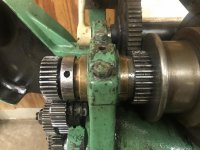Help: Tailstock 0.050" high. How do I align headstock to tailstock: bearings, shims?
Hi fellow SB Lathists,
After leveling the lathe and getting the fabri-cobbled motor bracket bolted to the floor, I spun up my 1921 SB 27-A 11" lathe, (probably its first time in 30 years), and everything seemed as expected. Took a few light passes, then went to drill and put a dead center in a 5" work-piece, and the tailstock isn't centered with the work; it's 0.050" high. I drilled and ran it anyway, and ended up with a ~0.010" diameter taper on the part (expected, but not acceptable).
I confirmed the tailstock is 0.050" higher than headstock center with a digital indicator+mag-base on the chuck, confirmed in all 4 quarters of the chuck, spinning the chuck around, with a 0.100" delta top-to-bottom, measured from a dead-center in tailstock (even changing and re-orienting dead-centers). I tore down the tailstock, cleaning all of the contact areas, to confirm there was no build-up or misassembly. (Note that there was actually ~0.010-0.015" wear on the tailstock-to-ways contact surface of the tailstock.) Reassembled, and the result is the same. There is no vertical adjustment on the tailstock.
On the headstock side, it looks like I have about 0.012" runout on the large bronze bearing, and 0.008" runout on the small bronze bearing, (per testing procedure with 12" bar). I've not yet removed the bearing caps, but, while assembled, it doesn't look there are many/any shims remaining, to take up the runout. That said, 0.012" runout on the large bronze bearing doesn't account for 0.050" misalignment.
From looking at it all, I'm not sure how to move the headstock back into alignment with the tailstock. Is there a way to shim the bearings vertically upward? With the bearings' concentric mating surface to the headstock, I have doubts they can be shifted vertically upward. There is the headstock-to-bed joint, that could possibly be shimmed, but that brings it's own issues, and may not fix the root cause of the problem.
Do I need new bearings to move the spindle upward? Is there somewhere I can shim? Any help would be appreciated! I'm stuck scratching my head, unsure of what to do from here.
Thank you!
-SB27A
*As an aside, I'd like to crack the bearing caps, to inspect, but does anyone know if there is a good bearing cap torque spec, considering this lathe was made before torque wrenches? SB's "Keep Your Lathe In Trim" bulletin only says "Tighten the cap bolts carefully, drawing them down with a uniform tension."





Hi fellow SB Lathists,
After leveling the lathe and getting the fabri-cobbled motor bracket bolted to the floor, I spun up my 1921 SB 27-A 11" lathe, (probably its first time in 30 years), and everything seemed as expected. Took a few light passes, then went to drill and put a dead center in a 5" work-piece, and the tailstock isn't centered with the work; it's 0.050" high. I drilled and ran it anyway, and ended up with a ~0.010" diameter taper on the part (expected, but not acceptable).
I confirmed the tailstock is 0.050" higher than headstock center with a digital indicator+mag-base on the chuck, confirmed in all 4 quarters of the chuck, spinning the chuck around, with a 0.100" delta top-to-bottom, measured from a dead-center in tailstock (even changing and re-orienting dead-centers). I tore down the tailstock, cleaning all of the contact areas, to confirm there was no build-up or misassembly. (Note that there was actually ~0.010-0.015" wear on the tailstock-to-ways contact surface of the tailstock.) Reassembled, and the result is the same. There is no vertical adjustment on the tailstock.
On the headstock side, it looks like I have about 0.012" runout on the large bronze bearing, and 0.008" runout on the small bronze bearing, (per testing procedure with 12" bar). I've not yet removed the bearing caps, but, while assembled, it doesn't look there are many/any shims remaining, to take up the runout. That said, 0.012" runout on the large bronze bearing doesn't account for 0.050" misalignment.
From looking at it all, I'm not sure how to move the headstock back into alignment with the tailstock. Is there a way to shim the bearings vertically upward? With the bearings' concentric mating surface to the headstock, I have doubts they can be shifted vertically upward. There is the headstock-to-bed joint, that could possibly be shimmed, but that brings it's own issues, and may not fix the root cause of the problem.
Do I need new bearings to move the spindle upward? Is there somewhere I can shim? Any help would be appreciated! I'm stuck scratching my head, unsure of what to do from here.
Thank you!
-SB27A
*As an aside, I'd like to crack the bearing caps, to inspect, but does anyone know if there is a good bearing cap torque spec, considering this lathe was made before torque wrenches? SB's "Keep Your Lathe In Trim" bulletin only says "Tighten the cap bolts carefully, drawing them down with a uniform tension."










